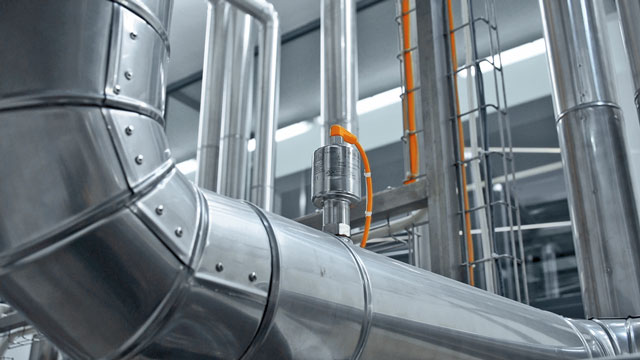In the challenging environment of the food industry, smart sensors offer outstanding performance and reliability but also provide substantial added value, says Andy Walker of IFM Electronic.

Automation systems in the food manufacturing and processing sector depend on data from huge numbers of sensors. The most important parameters monitored by these sensors include pressure, temperature, flow and level. Many of the specifications for these sensors are the same as those in any other process industry but, in the food sector, hygienic design is often an additional and critical requirement. And in some cases, the sensors must also be suitable for use in hazardous areas.
Sensors with added value
Many sensor products are available in hygienic versions designed specifically for food industry applications, and leading manufacturers of such sensors are increasingly focusing their development efforts on applying innovative technology to provide added value for users of their products.
A good example of these innovations is a new generation of level sensors that operate on the guided wave radar (GWR) principle. GWR sensors are installed vertically at the top of a tank and emit high frequency electromagnetic pulses that are guided downwards along a stainless-steel rod. The pulses are reflected from the surface of the medium in the tank back towards the sensor. The transit time of the pulses is used to evaluate the distance to the surface.
This technology provides important advantages over other types of level sensor. GWR sensors are unaffected by changing media (provided that the dielectric constant is greater than 5), changing temperature, gas blankets or vapours, or build-up of product on the probe itself. In addition, they can accurately and reliably measure liquid levels in many foaming applications.
The probes for the food industry versions of these sensors are made of high-grade stainless steel, and all other components follow hygienic design principles to meet the requirements of the European Hygienic Engineering and Design Group, EHEDG. Probes with different lengths are available and can be easily interchanged by the user to meet the needs of the application, or can be cut to length if required. The best of these sensors also has an IO-Link interface.
Another example of sensors that offer added value is provided by temperature sensors that incorporate two sensor elements with opposing temperature characteristics. The elements – Pt1000 and NTC thermistor – operate independently and are continuously monitored by a microprocessor in the sensor. This verifies that the measured temperature value is valid, based on a user defined temperature differential or “drift” between the two sensors. If the specified drift is exceeded, it is signalled immediately via a separate diagnostic output. Both measured temperature values are available by IO-Link.
The use of these sensors in temperature-critical processes provides assurance of measurement, and therefore process performance, between calibration intervals and may therefore reduce requirements for costly calibration.
Communication via IO-Link
With the growing adoption of Industry 4.0, communication between devices and systems has never been more important.
The latest generation of sensors uses digital protocol IO-Link as well as providing conventional analogue interfaces such 4-20 mA. With IO-Link, interference on the connecting cable to the sensor has no effect on the accuracy of the measurement – unlike analogue interfaces, where measurements can be severely affected by interference. Further, with IO-Link, multiple values from a single sensor can be transmitted simultaneously.
During maintenance and repair, since sensors can be configured via IO-Link, if a sensor has to be replaced the configuration data can be transferred directly to it. The time-consuming process of setting up the sensor on site is eliminated, so the time needed to put the plant back into service is significantly reduced. Users can even access self-diagnostic data from sensors that have an IO-Link interface, so that locating faulty devices is faster and more certain.
Data transmission to an ERP system
Digital sensor communication also allows the transmission of sensor data to ERP and other high-level corporate systems. A convenient way of achieving this is to use an agent connectivity port, a software gateway that supports bidirectional communication for a wide range of different interfaces. This makes possible communication between ERP systems and devices at the field, control and process control levels. Implementations specifically designed for the capture and transmission of data from IO-Link sensors are available and, with these, data can be transmitted directly from sensors to the ERP system without the need for it to pass through a PLC.
This is referred to as “Y communication” because the data splits, flowing via one branch to the PLC and via the other branch to the ERP and other corporate systems. This opens up possibilities that would be hard to implement with conventional sensors, such as datalogging, condition-based maintenance and improvement of energy efficiency.
The future
Smart sensors offer many advantages in the food industry and can significantly reduce costs. Today many automation solutions still use analogue sensors, but the adoption of sensors with IO-Link interfaces is increasing rapidly, as more and more users become aware of the added value they provide..
www.ifm.co.uk | 0208 213 0000 | enquiry.gb@ifm.com

